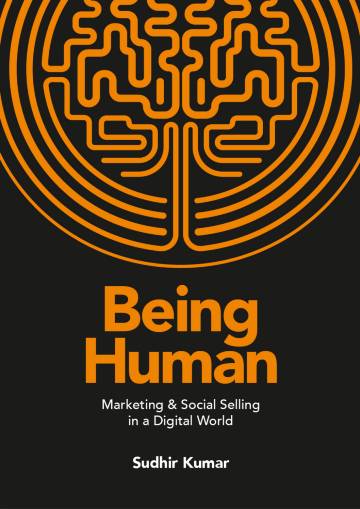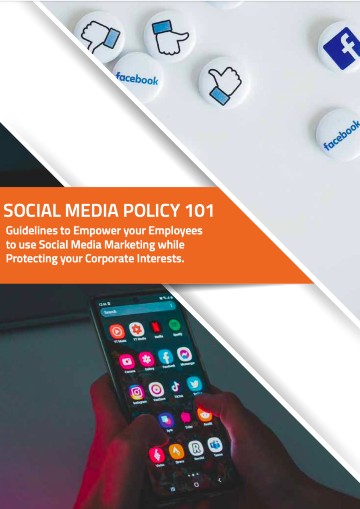
“We don’t have a choice on whether we do social media; the question is how well we do it.”
– Erik Qualman
Could you agree more? Today’s social media isn’t just a platform to help people pass the time; it has become an integral part of a person’s day. In all likelihood, most of the employees of your firm, too, participate in widespread social conversations online. Most of the brands across the globe today have begun to leverage the power of social media to improve their outreach and customer engagement. The concept of Employee Advocacy isn’t new, but it certainly has caught more momentum today than it had before.
If you look at this from a different perspective, it is an additional opportunity to leverage to gain extra attention for your business. After all, companies are driven by people’s connections; today, social networking is the largest global community. Therefore, elevating brand perception through getting people to talk about you the way you want is an avenue worth exploring.

However, some caveats need to be placed on the ‘how’ of this operation. It is as they say – the internet never forgets. To ensure that employees conduct themselves with dignity and integrity in an online social environment, there is a need to devise policies that demarcate a line of control that employees must observe.
It is a long-term task to build a brand image and project it how you want to in the digital world. So, you want to get it right from the get-go. So let’s now discuss the elusive ‘how’ of this entire shebang.
Easy Index
- What is a Social Media Policy?
- Why Do You Need a Social Media Policy?
- How to Draft Your Social Media Policy?
- What Your Social Media Policy Must Include (With A Few Cool Examples)
- What You Should Omit From Your Social Media Policy
- Creating Your Policy as a Tool to Generate Employee Advocacy
- Elements of a Good Social Media Policy
- Conclusion
What is a Social Media Policy?
A Social Media Policy is a dynamic, ever-evolving document that lays out the ground rules for your employees to play fair in the social media universe. How your brand is perceived worldwide depends on how your employees talk about it, so it is imperative to set a few terms that help you grow.
Scott Stratten said, “Social media doesn’t fix anything, it just amplifies things,” – and it couldn’t be more accurate. A Social Media Policy lets your brand smoothen down the creases on the social communications your employees participate in as part of your brand, such that whatever gets amplified is favorable.
By creating a policy for social media usage in the workplace, you create a set of commandments that govern how the disciples propagate the “vision” of your brand. One great example is Scott Monty’s 11 commandments for social interactions for the employees of Ford. While they aren’t mainly targeted towards the digital media, these commandments are so elemental that they make sense practically anywhere.
It works well to keep ambiguity out of your social media policy document. Take Intel’s policy document, for example. It outlines three detailed steps for its employees to follow when posting anything online professionally – while still being gentle.
The idea is to drive the point home by invoking responsible behaviour instead of imposing it.
To gain more detailed insights on social media policies, you can download Socxo’s Social Media Policy eBook now.
Why Do You Need a Social Media Policy?
A social media policy empowers a brand to maintain necessary confidentiality at a large scale while utilizing the outreach that comes with leveraging employee’s social networks to further its growth. With this guideline, the snowball that could potentially result from an employee’s blunder can be prevented at the source.
Let’s look at other amazing things you can do with a social media policy:
- Create a cohesive brand image. Ten employees say ten different things about the same topic – your brand isn’t any different. Getting a policy in place regulates the information that goes out of your office. However, building a brand image that stays gelled together by a central idea at its core isn’t impossible.
- Stay within legal and regulatory boundaries. An inadvertent faux pas that reveals sensitive information covered by legal or regulatory mandates can be prevented with a well-structured social media policy. Letting your employees know which information is A-OK and a strict no-no works wonders to maintain a healthy confidentiality bar.
- Prevent cataclysmic PR blunders. Oh, you’ve all seen how an organization unravels at the slightest of informational slip-ups. One of the primary reasons that social media policies exist is to prevent such difficulties from ever occurring. No company ever wants its data to be stoned to death in public – a social media policy is your shield from such catastrophes.
- Deal with the aftermath. If some information somehow slithers out of the organization, a social media policy consists of SOPs and protocols required to be followed for damage control.
- Promote ownership. With a social media policy, you encourage the employees to own up to the words they release to social media. Not only does this sensitize them to the brand’s objectives, but it also creates an environment of responsible posting.
- Security breach prevention. The horror stories of social media accounts getting hacked never end. This is where a social media policy comes in handy – you can set security protocols for your employees, like frequently updating passwords and such, to ensure everything stays secure within a digital fortress.
- Healthy marketing! Imagine the avenues that open up with each employee’s social network – it is a boon for the marketing targets of your business. By selectively leveraging the social media of your company’s key employees, a social media policy ensures that such promotion of your brand happens optimally.
The benefits of a considerate social media policy that cares about the company’s employees can save a company in the public eye. According to this study:
8 in 10 workers report using social media in the workplace.
And 98% of employees use at least one social media site for personal use, of which 50% are already posting about their company.
Hence, the absence of a viable, non-repressive social media policy could be disastrous for the company. Moreover, it could potentially result in massive damage to brand image – no matter how popular the name is, it will take the fall. Take this example of HMV, the well-known music retailer, and its social media laxity:

From a store that owns more than 100 retail outlets across the UK, this is unexpected. It is to prevent such mega-disasters that social media policies exist. In another incident, there was an offensive tweet from the account of Chrysler Autos (the user may have forgotten to switch to their personal account before posting – who knows?)
It is essential to separate employees’ personal opinions from that of a brand. Through a well-thought-out social media policy, this can be achieved. How to do that, exactly? Let’s find out.
How to Draft Your Social Media Policy?
A healthy working environment promotes productivity. Interestingly enough, an article published by the International Review of Management and Marketing analyzes several studies that show that social media can boost interpersonal communication and employee performance at the workplace if used positively and maturely. This is the kind of statistic you want to tap into when creating a social media policy.
Rather than making it restrictive, the aim should be to craft it as an enabler of positive social interactions insofar as the brand is concerned. So here is a skeletal guideline you can follow to create a social media policy that is as friendly as stringent.
1. Let it Be Natural
In a world that is moving full-throttle into the realm of artificial intelligence to connect with consumers, a little human touch gives a consumer a brand the certification of reality. So, if anything, a social media policy should encourage human interactions between the employees of your firm and the consumers; it helps to assure your audience that your brand is the real deal, operating with real people ‘behind the screens.’
It does help your business to tap in on the social network of the employees. In fact, it has been found that millennials prefer working at offices that allow peeking into social networks every once in a while. Given that most of the workforce are millennials today, a catalytic social media policy will bring in better results than another rulebook.
2. Play Fair Game
There is no problem in your employees posting content online (unless it harms the brand image) – as long as it is genuine. A social media policy must always ensure that all the sources, references, bibliography, or any other credit, for that matter, are duly mentioned. Plagiarism, while not necessarily intentional, has serious legal consequences. A simple incident of forgetfulness can cause a landslide of copyright infringement issues if certain data borrowed from another source remains unreferenced.
For this reason, it is necessary to lay down the guidelines that require your employees to cite all the references they used. Think of it like this: what if the data from your blogs or reports get used without your business knowing or getting credit for it? Wouldn’t you press charges?
The competition for consumers is a level field as far as the digital space is concerned. Playing fair is the only way that your business will be able to utilize its true potential. Advocate fairness through your social media policy.
3. Let There Be Clarity
Ambiguity can be dangerous. Leaving too much in the grey areas, open to interpretation, or explained in unclear words leaves wiggle room for disaster to make its move. In addition, there could be severe legal repercussions of using an unclear social media policy.
Ensure that your brand encourages worded conversations online through and through. Whether blogs, whitepapers, reports, datasheets, studies, tweets, or any other form of public release – it should be neutral, factually worded, and understandable.
4. Promote Professionalism
Social media has made everyone – everyone – impatient. People want things to get done within seconds by typing out a post and seeing it getting shared and liked. Employees can make typographical blunders that could ruin the image – their own and the brand they represent.
A social media policy must be put in clauses that “filter” such errors (or misadventures, if you will). For better context, here is an eye-opening example where New England Patriots’ administrators were left to clean up the mess the lack of a “filtration” system left them with:

Your employees are the representatives, the facade of the human values of your company. Therefore, their radical views or opinion should not impact professionalism in any way.
5. Information Security and Confidentiality
One of the most important reasons for social media policies is that there can be no better security over such a vast network than proactiveness and awareness. Yet, due to a lack of familiarity with using apps or other contemporary methods of social communications, debacles of incomprehensible magnitude are often set in motion. Here is an example, when the very CFO of Twitter, Anthony Noto, unwittingly tweeted sensitive insider information:
 The Twitteratis were, expectedly, quick to respond and relatively unforgiving.
The Twitteratis were, expectedly, quick to respond and relatively unforgiving.
These were the rudimentary things a sound social media policy needs to cover. It is time to learn from the good experiences that certain brands got right on their social media policies that make total sense for contemporary use. Read on.
What Your Social Media Policy Must Include (With A Few Cool Examples)
A social media policy governs how impressive your brand would look in an online (sometimes even offline) landscape. Some of the must-have features that your social media policy must have are:
- Clearly defined “rules” govern how employees post when they speak for the brand and how they speak about it.
- Who the authorized spokespersons are
- Points of contact within the company in case there is doubt about posting specific information about a brand.
- Whom to contact in case you spot social media misuse in brand matters
- Encouraging words that promote inclusivity, positivity, and a healthy social environment online
- Security protocols
To understand these highlights better, let’s look at some ideal examples of what significant social media policies look like.
1. Coca-Cola
There isn’t a policy second to the one Coca-Cola has prescribed for its employees, speaking of detail and inclusivity. Instead, it speaks in detail about the 5 core values that must be observed while posting anything to social media:
- Transparency in the information delivered
- Protection of consumer privacy
- Respecting others’ rights
- Technological responsibility
- Utilization of best practices available
The policy defines who the spokespersons are, which is essential, considering this is a well-known brand. Whatever its employees are saying will be heard by a lot of people. Another fantastic thing this policy does is point out whom to contact if you are faced with a posting dilemma. When in doubt, ask away!
2. Dell
Who doesn’t know this brand? The chances are that half the corporates in this world use technology distributed by Dell. Fact is, there are more things to love about this brand’s social media policy when compared to every other one. Here is why. It legit tells its readers this:
“Social media is another tool you can use to build our brand; just be sure you do it the right way.”
This policy is genuinely casual about social media usage – but in no way compromises the values or objectives it seeks from its employees. Thus, in a fun way, Dell manages to effectively communicate the level of responsibility and professionalism it expects from its employees.
Iterating: the policy is fun to read. While separating the Do’s and Don’ts of the social networking behaviour, it still manages to communicate to the employees that they are free to interact with the world. This is an excellent method to encourage positive, growth-oriented brand image marketing.
3. Best Buy
This retail brand takes things further with its social media policy by creating two sections that list what to do and what not to do.
“Protect the brand. Protect yourself.”
Their motto is clear enough.
Speaking of clarity, since this is a notable brand in retail, it further (and gently) tells the workers that the policy holds even after work hours. The very essence of having a social media policy in place is captured splendidly in Best Buy’s document. What’s best about it is it links further to other approaches relevant to workers dealing directly with customers.
Another point of great contemporary importance that this policy beautifully highlights is humanity. Cultural, racial, religious, and many other differences are to be respected is what it says – bringing in mutual respect and inclusivity. Recognizing diversity on an official document in this manner is a commendable move by Best Buy. Focusing on it closely helps them create a brand image that welcomes all buyers alike; it works well for retail.
These epitomes of social media policies set the bar on what your company should be aiming for. While on the same topic, it is now time to discuss what this crucial document should not include.
What You Should Omit From Your Social Media Policy
Brand image is built slowly, brick by brick—social media usage guidelines on-board your employees to help the brand achieve its vision. However, every employee is a part of the big picture and has a role, which the policy must consider.
Creating an environment of healthy social media usage in the workplace means that the policy needs to be uplifting. In inspiring your employers to share information about the brand, the policy should avoid talking about the consequences of doing wrong. It sounds threatening, to say the least – and is the fast-forward way to employee attrition.
Oracle’s social media policy does employee intimidation (strong word, but yes) by mentioning that employees are not authorized to share on behalf of the company. Note that the same thing can be done in subtler words differently. A social media policy should guide the employees, not command them.
Refrain from mentioning any personal consequences to defaulting. Instead, encourage positive, brand-friendly social networking behavior with examples, if necessary.
Another aspect that needs to be kept out of this document is ambiguity. Using long-winded sentences with words difficult to understand results in reduced comprehension. What can be said in 10 words shouldn’t be printed out in 20; keep matters terse. As far as possible, the language should be conversational while still retaining a touch of authority. It is an authoritative document, after all.
Often, specific policies detail the legal aspect of deviating from what is agreeable. While it is a necessary evil to bring the employees face-to-face with the rules as they are, placing too much emphasis on how it works may intimidate them.
It is as Neil Patel emphasizes: “Create content that teaches.”
To sum it up, a social media policy needs to be a friendly guide that sets the stage for your brand to stay safe in the vulnerable digital environment. Of course, there is never a full guarantee that things won’t go wrong – but nothing is perfect. So focus on making a social media policy as close to perfect as possible.
Creating Your Policy as a Tool to Generate Employee Advocacy
According to the Edelman Trust Barometer study, 54% of the consumer base is more likely to trust a regular employee of a brand rather than the CEO. Employee advocacy, when designed to cascade down to every rung in the organizational ladder, can bring in quality leads.
Creating a social media policy that empowers (to a suitable degree) every employee of your firm to talk about the brand builds an unshakeable customer engagement in the long run. In addition, a policy that places the freedom to share in the palm of the employees fosters confidence and faith in the brand name.
It is especially relevant in the post-pandemic scenario where social media has rooted itself deeply in the very fabric of doing business – it can’t be left out in the rain any longer. Employee advocacy isn’t an ignorable option; it is an active strategy that brands are arming their flagships.
When creating a social media policy, it is important to include elements that enable employees to talk about the brand positively. The policy is a tool to boost KPI metrics when it comes to consumer engagement.
To engage with the consumer base with the latest news and launches, feedback, polls, votes – the whole shebang – to pique consumer interest and garner attention truly. A compelling social media policy:
- Specifies what sites employees are allowed to use at work.
- Establishes who can speak for your company on social media.
- Ties in with other company policies such as acceptable use and code of conduct.
- Works with the organization’s IT team to determine what security requirements are appropriate.
- Provides guidelines for interacting with people via official accounts.
Elements of a Good Social Media Policy
When 7 in 10 Americans today are using social media to connect, there is no reason why an employer shouldn’t actively leverage these connections to further its outreach goals. But, to be able to do that in a dignified manner, a social media policy must:
- Determine Accessible Content. The conservative view of barricading the social media sites off isn’t going to work anymore. Instead, the policy should determine which social networks can be accessible and which ones should be blocked.
- Determine Spokespersons. A good social media policy transparently disburses authority to certain designatory spokespersons. Inadvertent sharing of unauthorized information is thus prevented.
- Determine The Conduct. Most brands require their employees to disclose who they are and how they are related to the brand before posting anything online. This is an excellent way to trace back any negative comment; however, it isn’t encouraging. A good policy imbues good conduct in the employees.
- Reinforce Confidentiality. Demarcating the line of information that employees must not cross helps preserve the confidentiality of sensitive information.
Conclusion
It is possible to bring about high relevancy and positive sentiment in the workplace with a social media policy based on sound principles. Using social media technologies with knowledge, workers could achieve cost reductions of 30% to 35%.
Facebook, Twitter, Instagram, and even LinkedIn are the social hotspots today where employees steal a few moments away from work to unwind before the next task. A lot of what they say about the company and its work environment depends directly on how they perceive their interactions with the decision-makers in the workplace.
Understanding that the social web spreads globally, businesses can solidify their positions globally through their employees on this media. Moreover, furthering the brand’s interests by making the employees a part of the clockwork helps the brand reach its goals smoothly.
By creating a guideline for ethical, responsible use of social media, you encourage employees to build meaningful networks in the digital space that directly benefits the business and the brand. When the employee and the business work in tandem, the latent potential of a company are unleashed, and new heights can then be scaled.
Interested in knowing more about social media policies and discover innovative ways to benefit from them? Download Socxo’s Social Media Policy Ebook now. The book outlines 8 pointers to help you draft your social media policy and provides relevant examples of companies getting it right. A must-read for anyone wanting to foray into the fascinating subject.























